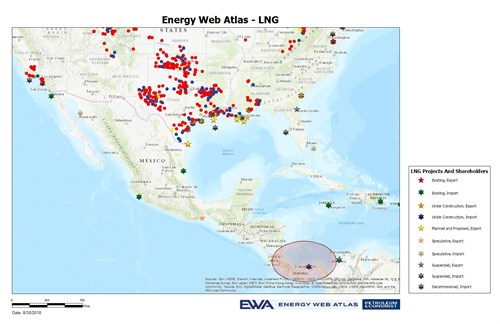Panama, U.S. to sign pact to expand regional access to LNG
WASHINGTON (Reuters) - Panama will sign an agreement with the U.S. Treasury and Energy departments aimed at paving the way for more private investment to expand the importation and distribution of U.S. liquefied natural gas in Latin America.
 |
| Map Source: EWA |
David Malpass, Treasury undersecretary for international affairs, said he hopes the “framework agreement” is the first of several with countries in the region to encourage investment to increase access to cheaper, cleaner energy.
The agreement is part of a Treasury-led initiative called America Crece, incorporating the Spanish word for growth, aimed at boosting U.S. LNG exports, developing Latin American energy resources and downstream demand.
Malpass is in Panama for the signing and the inauguration of a major new LNG terminal and 381-megawatt gas-fired power plant in Colon, Panama, run by U.S. power company AES Corp.
He said in an interview that new investments encouraged by the agreement will help turn the AES Colon project into an LNG distribution hub, with cargoes imported from the United States sent to other countries in the region, including Guatemala, Honduras, Nicaragua.
These countries and many Caribbean islands now rely largely on oil to generate electricity, with Venezuela a major supplier.
In 2017, French utility Engie and AES established a joint venture to market and sell LNG to third parties in Central America using the Panama terminal as a distribution hub.
The $1.15 billion AES facility on Panama’s Caribbean coast, which is expected to begin commercial generating operations on Sept 1, and LNG tank distribution operations in 2019, took in its first U.S. LNG cargo in June.
The Panama agreement allows for the U.S. agencies to help address regulatory and other barriers to investment, Malpass said, which can create opportunities for downstream demand and distribution.
“The framework agreement itself squarely addresses the obstacles that the private sector may be finding in that country,” Malpass said. In the case of Panama, he added, the framework agreement with the United States is a signal from Panama to the world that it welcomes investment, in particular private sector funding of projects.
The agreement also aims to encourage increased electrical grid access in rural areas of Panama and Central America and adoption of new technologies such as battery storage to improve reliability and foster economic development, he said.
Reporting by David Lawder; Editing by Steve Orlofsky

- ExxonMobil halts 1-Bft3d blue hydrogen project in Texas
- Aramco and Yokogawa commission multiple autonomous control AI agents at Fadhili gas plant
- Ukraine will resume gas imports via Transbalkan route in November
- Mitsubishi to inject $260 MM into Brunei LNG project
- Freeport LNG (U.S.) on track to take in more natgas on Thursday after unit outage



Comments